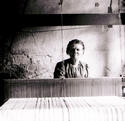 Calton's original name was Blackfauld and in 1705 John Walkinshaw (1671-1731) began to develop the lands as a weavers' village. However, this zealous Jacobite was ruined because of his involvement in the 1715 uprising and Glasgow Town Council acquired Blackfauld in 1723. The new proprietors called the community Calton and the name remained even although municipal ownership was short-lived. The Orr family purchased Calton in 1730 and thereafter the village expanded eastwards.
Calton's original name was Blackfauld and in 1705 John Walkinshaw (1671-1731) began to develop the lands as a weavers' village. However, this zealous Jacobite was ruined because of his involvement in the 1715 uprising and Glasgow Town Council acquired Blackfauld in 1723. The new proprietors called the community Calton and the name remained even although municipal ownership was short-lived. The Orr family purchased Calton in 1730 and thereafter the village expanded eastwards.
 Calton had an industrial character even before cotton manufacture began to take off in the 1770s. Pottery making was a distinctive and successful local trade, while handloom weaving was a major means of employment. Textiles brought prosperity, but as the 18th century progressed and the pace of industrialisation accelerated, the Calton weavers were less able to protect their trade. They became increasingly dependent on piecework from manufacturers and a dispute over wage-rates provoked a bitter strike in 1787. Three weavers were shot dead as a result of military intervention during a demonstration. The strike has since been celebrated as one of Glasgow's most dramatic early experiences of industrial militancy.
Calton had an industrial character even before cotton manufacture began to take off in the 1770s. Pottery making was a distinctive and successful local trade, while handloom weaving was a major means of employment. Textiles brought prosperity, but as the 18th century progressed and the pace of industrialisation accelerated, the Calton weavers were less able to protect their trade. They became increasingly dependent on piecework from manufacturers and a dispute over wage-rates provoked a bitter strike in 1787. Three weavers were shot dead as a result of military intervention during a demonstration. The strike has since been celebrated as one of Glasgow's most dramatic early experiences of industrial militancy.
 Immediately adjacent to Glasgow, Calton was a relatively large community with an estimated population of 6,695 in 1791. It was predominantly working-class, but there were also wealthy residents such as the textile magnate David Dale (1739-1806) whose home in Charlotte Street overlooked Glasgow Green. Concerns about policing and environmental problems prompted calls for more effective local government and in 1817 Calton was turned into a self-governing burgh of barony with its own provost and council. Calton soon acquired a reputation for the efficiency of its administration, and when the burgh was annexed to Glasgow in 1846, many of its practices were adopted by the city.
Immediately adjacent to Glasgow, Calton was a relatively large community with an estimated population of 6,695 in 1791. It was predominantly working-class, but there were also wealthy residents such as the textile magnate David Dale (1739-1806) whose home in Charlotte Street overlooked Glasgow Green. Concerns about policing and environmental problems prompted calls for more effective local government and in 1817 Calton was turned into a self-governing burgh of barony with its own provost and council. Calton soon acquired a reputation for the efficiency of its administration, and when the burgh was annexed to Glasgow in 1846, many of its practices were adopted by the city.